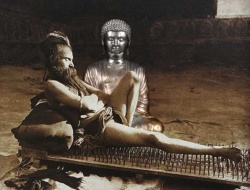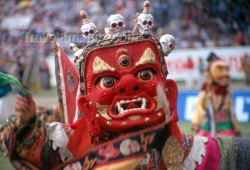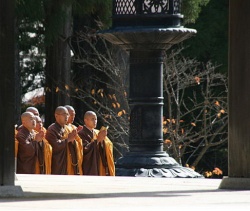Martial arts: Does it float?
In the Navy, one question is always paramount when considering the usefulness of a warship, "Does it float?" If a warship does not float, then its weapons systems are useless. When evaluating a fighting system, the paramount question should be, "Does it float?" Does the system protect you when you need it? If not, then it is useless.
When dealing with the “arts” part of the martial arts, beauty is in the eye of the beholder. Just as in other arts, such as dancing, where some people enjoy ballet and others like to hip-hop, people have different likes and dislikes within the martial arts. Some people move quickly and gracefully so they enjoy soft styles that use graceful movements. Some people move slowly and powerfully, so they enjoy hard styles that use powerful movements.
When it comes to the arts, there is no best art, only the art that best pleases the beholder or practitioner of the art. Each martial art may have its own unique theories, movements, and techniques, which may or may not be effective in fighting, but as long as the art’s practitioners enjoy practicing the art of the martial art, that is all that matters.
However, dealing with the “martial” part of the martial arts is a different story. No matter how beautiful the art, how relaxing it is, or how much fun it is to train in the art, the techniques promoted by the art must be able to be used simply, effectively, and efficiently:
- By anyone large or small, fat or skinny, man or woman, etc.)
- Under any conditions (wearing gym clothes or a tuxedo, wearing a tee shirt or a winter coat, in the sun or in the rain, against a single attacker or multiple attackers etc.), or
- In any location (alone in an alley or on a crowded bus, on a smooth tiled floor or in glass strewn alley, etc.)
Self-defense is not complicated; it has been used by mankind since Adam and Eve. However, it is not always effective; remember what happened to Able when Cain attacked him
If I want to know if an object someone is trying to sell me will float, I do not need to measure it, weight it, or analyze it; I just throw it into the water and see if it floats. The seller may make all kinds of claims, show me the history of the object, tell me how it has floated in the past, tell me how well it performs in the water, and tell me how beautiful it is, but the bottom line is, when I throw the object into water, does it float?
When evaluating a martial art, you should consider...
What results do you seek?
Are you looking for a hobby or are you interested in staying fit, learning to defend yourself, or competing in ring, or are you just seeking some type of self-satisfaction to build your ego?
Is it safe to use?
Can you use the art safely? Are the results predictable? Is it easy to unintentionally kill or seriously injure an opponent? Do the techniques put you in danger?
Does it work?
The martial art may be impressive in demonstrations or in controlled situations, such as in class or in the ring, but does the martial art work when used in real-life situations?
Is it worthwhile?
Does all the training, effort, money, and time spent learning the art justify the results as compared to the results you were seeking?
Float test
The true test of a martial art is—does it float? When it is thrown into the water and put to the test against an angry assailant who is intent on harming you, will the techniques you have learned from the martial art keep you from sinking?
To float, a martial art must:
- Make full use of all your natural weapons, such as hand, feet, elbows, knees, etc. This includes using the weapons for all types of fighting, such as striking, grappling, throwing, choking, locks, pins, etc.\
- Be effective and efficient in its use with no wasted motion or useless techniques.
- Be logical, instinctive, and easy to learn and apply.
- Be capable of lethality and yet offer a full-range of response options so that the level of force used in a specific situation may be appropriate for the circumstances.
- Provide reasonable survivability against numerically or physically superior opponents without the outcome becoming a “Pyrrhic victory.” A Pyrrhic victory is when the victory costs more than it was worth to win; for example, when gunman confronts you and your family and you overpower the gunman, but your family dies during the struggle, you may have won the victory but ruined your life.
- Be instinctive and reactionary instead of requiring conscious thought. Since most attacks come as a surprise, come hard and fast, and are numerous, there is no time to think.
- Provide predictable results that are repeatable under varying circumstances What is the water test used to evaluate the soundness of a martial arts? One may think it is whether the martial art works in street confrontations, but this is not a reliable test since there are not enough data on street confrontation available from which to draw any significant conclusions. Violent street self-defense confrontations that involve the public are very rare, and confrontations that involve a trained martial artist are extremely rare. There are certainly people who thrive on violence, such as street fighters, gang members, and violent drunks, but their confrontations are rarely documented and when the fighters talk amongst themselves, the truth is rarely spoken. Losers, or winners for that matter, will not speak favorably of the effectiveness of their opponents’ techniques or be critical of their own techniques
Warfare test
So, since the martial arts were originally designed for warfare, why not evaluate them on the battlefield. World War I was the last war when hand-to-hand combat was plentiful. It was fought by men fighting each other in and between the trenches. Nowadays, hand-to-hand warfare is practically nonexistent. Soldiers get a little hand-to-hand combat training in the latest "in" martial art during boot camp, and then they never see it again. Special Forces get more training, but they are only a very small portion of the armed services and even they seldom get to use the techniques in actual combat. Nowadays, we shoot and blowup the enemy from a distance, rarely ever seeing their faces.
Police test
How about letting the police test the effectiveness of a martial art? The primary power of police is their authority. Due to our upbringing, there is an innate feeling that we must submit to proper authority. Therefore, the police rarely use physical contact and, when they do, it is primarily used only to get the suspect into handcuffs. Suspects may resist, but they rarely try to hurt the officers. As with soldiers, police officers rarely train regularly in any martial art.
Street test
To perform a valid test of the effectiveness of a martial art, you have to pit a person trained in the martial arts against untrained attackers and against attackers trained in other martial arts, and these tests must be repeated thousands of times under controlled conditions. These confrontations must be observed by impartial observers trained to know what to look for. Then the data collected from all these tests must be analyzed using set criteria that fairly evaluate the effectiveness of each martial art. The only place this occurs is in the professional fighting ring.
Competition test
In the sport or amateur ring, winning is desired but it is tempered by the competitors’ desire to avoid injuries that may adversely affect their lives or livelihood. Therefore, they fight for enjoyment and personal satisfaction, but avoid fights that may cause serious or permanent injury. Most of their martial arts training is geared toward this end. Professional fighters also fight for these same reasons but winning is their livelihood. If they do not win, their family does not eat. Therefore, they use whatever is permitted under the rules of competition to win. If it works, they use it. If it does not work, they do not use it. They are not slaves to any particular martial art.
Even in sport competition, you usually see common fighting styles. At a taekwondo tournament, all the fighters use taekwondo techniques, at a Judo tournament they use Judo techniques, etc. However, if you watch an open karate competition where all standup martial art styles may compete, you see common, basic techniques used, no matter the style of the competitor. In open tournaments, you rarely see soft martial art techniques used and you rarely see a variety in hard martial art techniques. The techniques used are evasion, using a tight guard to block attacks, and using basic punches and kicks—they are what work.
Professional boxers make their living from fighting. They have limited rules of engagement, but they are free to use any type of stance, knee spring, sine wave, ki, etc. that they want to use. There is always the pressure to conform to the traditions of boxing but if a technique is permitted by the rules, a boxer will use it to win. Yet boxers not use exotic techniques nor do they claim to use them—they just use what works.
Professional full-contact fighters, with the exception of some full-contact styles, such as Muay-thai, may use any style of martial art they choose and they are permitted to use pressure point strikes, vertical punches, sticky hands, foot sweeps, throws, drop kick, flying kicks, etc. To make a living at fighting, a professional fighter needs to knockout or submit opponents, or at least impress the judges with their superior fighting skills; therefore, one would assume that they would use techniques that have been proven to work. Why do not ultimate fighters use pressure point techniques in the ring; they have open hands and the techniques are permitted. Why do not they use Capoeria, Gung-fu, Aikido, etc. techniques in the ring if these are so effective; it is simple—they do not work! I have never seen or heard of any professional boxer or fighter who uses any soft martial art techniques in the ring, they only use what has been proven to work.
Why do all martial arts seem to work?
Why are diet books always best sellers? Because all diets work! Try any diet and it will work, at least for a few weeks. Why? First, anything you do to reduce calories will work. Second, starting a diet requires you to be aware of and watch what you eat. This in itself will cause you to loose weight. However, if you did this every day, you would lose weight without a "diet." This concept also applies to the martial arts.
First, all martial arts "work." When it applies to self-defense, practically any type of martial art training is better than none at all. Second, being aware of self-defense and practicing a martial art will make you feel more confident than you would with no training. When you train in a martial art, become more proficient at it, and are around it all the time, you tend to believe your martial art is the best. The best tool to use to drive a nail is a hammer; however, with enough practice, you can drive a nail with practically any hard object.
How well does it float?
Sometimes a martial art may appear effective and may initially float when thrown into the water, but it may have so many holes that it gradually sinks. Sometimes a martial art's techniques appear effective, especially when used during training classes and demonstrations, but when they are tested in the water of an actual attack, the holes in the techniques allow attacks to penetrate and the martial art sinks.
Sometimes, when a martial art is thrown into the water, it will plunge beneath the surface, but, if it is a true floater, it will quickly rise to the surface and float. For example, an aggressive attacker or multiple attackers may seem at first to be overwhelming, but effective evasion, blocks, and counterattacks will bring a good martial art back to the surface.
Do not be fooled by the shiny new speedboat sitting in the dealer’s showroom. It may have a lot of gadgets and features, but if it has holes in its hull, it will be useless when put into the water.
If you enjoy training in your martial art, then keep training, but do not be fooled by the hype of the martial art. Look at what is happening in the ring and in the real world and then use your reason, logic, and common sense to evaluate the effectiveness of your martial art and to see if it floats.






